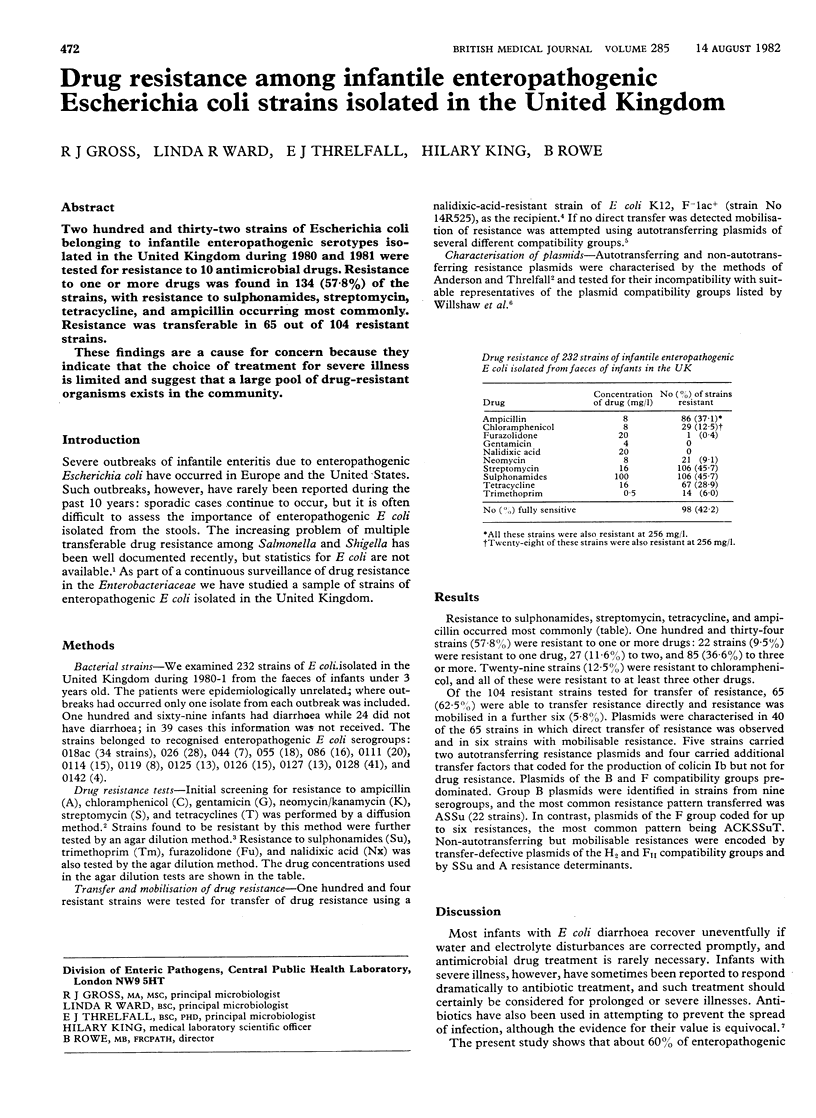Abstract
Two hundred and thirty-two strains of Escherichia coli belonging to infantile enteropathogenic serotypes isolated in the United Kingdom during 1980 and 1981 were tested for resistance to 10 antimicrobial drugs. Resistance to one or more drugs was found in 134 (57.8%) of the strains, with resistance to sulphonamides, streptomycin, tetracycline, and ampicillin occurring most commonly. Resistance was transferable in 65 out of 104 resistant strains. These findings are a cause for concern because they indicate that the choice of treatment for severe illness is limited and suggest that a large pool of drug-resistant organisms exists in the community.
Full text
PDF

Selected References
These references are in PubMed. This may not be the complete list of references from this article.
- Anderson E. S. A rapid screening test for transfer factors in drug-sensitive Enterobacteriaceae. Nature. 1965 Dec 4;208(5014):1016–1017. doi: 10.1038/2081016a0. [DOI] [PubMed] [Google Scholar]
- Anderson E. S., Lewis M. J. Characterization of a transfer factor associated with drug resistance in Salmonella typhimurium. Nature. 1965 Nov 27;208(5013):843–849. doi: 10.1038/208843a0. [DOI] [PubMed] [Google Scholar]
- Anderson E. S., Threlfall E. J., Carr J. M., McConnell M. M., Smith H. R. Clonal distribution of resistance plasmid-carrying Salmonella typhimurium, mainly in the Middle East. J Hyg (Lond) 1977 Dec;79(3):425–448. doi: 10.1017/s0022172400053286. [DOI] [PMC free article] [PubMed] [Google Scholar]
- Frost J. A., Rowe B., Vandepitte J., Threlfall E. J. Plasmid characterisation in the investigation of an epidemic caused by multiply resistant Shigella dysenteriae type 1 in Central Africa. Lancet. 1981 Nov 14;2(8255):1074–1076. doi: 10.1016/s0140-6736(81)91277-0. [DOI] [PubMed] [Google Scholar]
- Grindley N. D., Grindley J. N., Anderson E. S. R factor compatibility groups. Mol Gen Genet. 1972;119(4):287–297. doi: 10.1007/BF00272087. [DOI] [PubMed] [Google Scholar]
- Haltalin K. C., Markley A. H., Woodman E. Agar plate dilution method for routine antibiotic susceptibility testing in a hospital laboratory. Am J Clin Pathol. 1973 Sep;60(3):384–394. doi: 10.1093/ajcp/60.3.384. [DOI] [PubMed] [Google Scholar]
- Lambert H. P. Antimicrobial agents in diarrhoeal disease. Clin Gastroenterol. 1979 Sep;8(3):827–833. [PubMed] [Google Scholar]
- McConnell M. M., Smith H. R., Leonardopoulos J., Anderson E. S. The value of plasmid studies in the epidemiology of infections due to drug-resistant Salmonella wien. J Infect Dis. 1979 Feb;139(2):178–190. doi: 10.1093/infdis/139.2.178. [DOI] [PubMed] [Google Scholar]
- Rowe B., Frost J. A., Threlfall E. J., Ward L. R. Spread of a multiresistant clone of Salmonella typhimurium phage type 66/122 in South-East Asia and the Middle East. Lancet. 1980 May 17;1(8177):1070–1071. doi: 10.1016/s0140-6736(80)91509-3. [DOI] [PubMed] [Google Scholar]
- Willshaw G. A., Threlfall E. J., Ward L. R., Ashley A. S., Rowe B. Plasmid studies of drug-resistant epidemic strains of Salmonella typhimurium belonging to phage types 204 and 193. J Antimicrob Chemother. 1980 Nov;6(6):763–773. doi: 10.1093/jac/6.6.763. [DOI] [PubMed] [Google Scholar]


